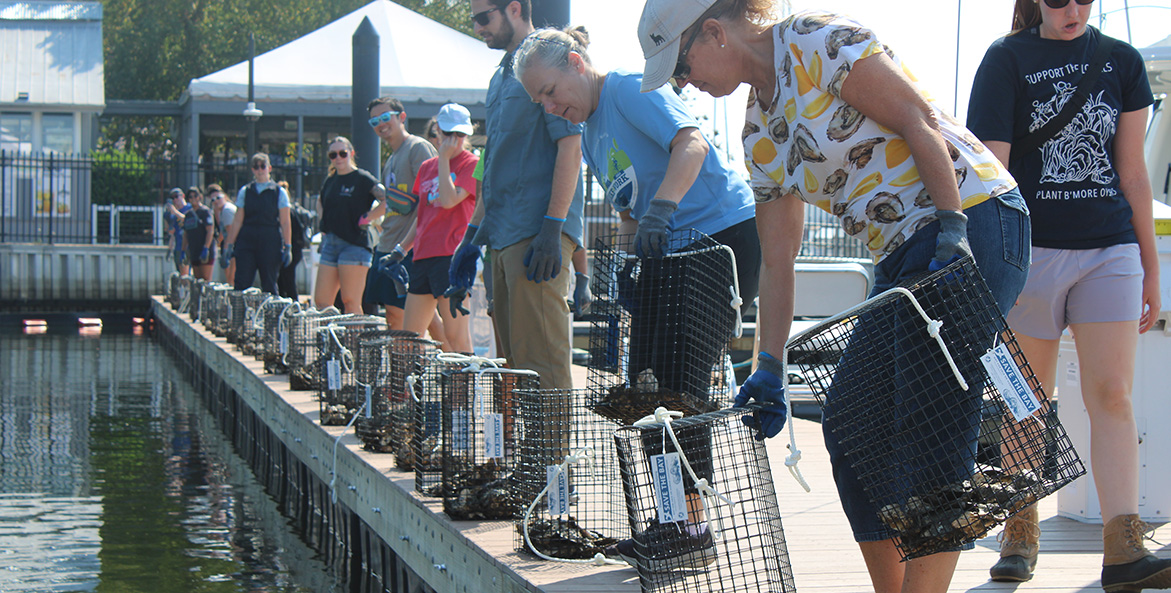Winter 2024
Baltimore Grows State's Largest Public Oyster Garden
Baltimore is now home to Maryland's largest public oyster garden. CBF, with Waterfront Partnership of Baltimore and dozens of volunteers, installed over 100 oyster cages at Lighthouse Point Marina this fall. Oysters are a vital resource for improving water quality and providing habitat for other species. But they often need help from our volunteers to grow. Aaron Tsui, long-time CBF oyster volunteer, says he likes oyster gardening, "for the sense of community and to spread awareness to help clean the Bay."
The oyster cages at Lighthouse Point Marina are filled with baby oysters, called spat, which CBF set on hundreds of recycled oyster shells. They will hang from the marina dock and grow for about nine months. This process keeps the oysters, which are most vulnerable during their first year of life, elevated from the Harbor's muddy bottom. Oyster gardeners like Aaron will check and tend to them throughout the year. Eventually the oysters are taken to their forever home on the protected sanctuary reef at Fort Carroll just outside Baltimore Harbor.
Kent Island Development Faces Legal Opposition
In the fight for a healthier community and Chesapeake Bay, several Kent Island residents, in partnership with CBF, Queen Anne's Conservation Association, and Chesapeake Wildlife Heritage, took legal action against a proposed 100-acre residential development known as Chesterhaven Beach—much of which falls within Maryland's designated Critical Area. Residents are objecting to the County Board of Commissioners' decision to approve the development, despite the sensitive waterfront land that it would harm.
The Cheapeake Bay Critical Area law passed in Maryland in 1984 to protect land within 1,000 feet of high tide of tidal wetlands and minimize the risk from new development to Bay water quality, habitat, and wildlife. Chesterhaven Beach includes 1.6 miles of vulnerable and ecologically important shoreline. Queen Anne's approval sidesteps this state law. In August, CBF and partners filed a petition for judicial review of the county's decision, which the Circuit Court is currently reviewing.
Maryland Farmers Lead the Way in Regenerative Agriculture
In October, CBF hosted Maryland policymakers at two Frederick County farms that are improving soil health, water quality, climate resilience, and biodiversity through regenerative agriculture. Although agriculture remains a top contributor of pollution in the Chesapeake Bay, many Maryland farmers are going above and beyond to improve their practices and the environment. These practices include things like crop diversification and rotation, and rotational livestock grazing, which improve soil health and absorb nutrients rather than let them run off into our waterways.
At the event, Maryland policymakers, farmers, and environmental leaders saw hands-on demonstrations of regenerative agriculture in action, and how it can directly improve both farm businesses and the environment. Implementing these practices across the Chesapeake Bay watershed would be one of the fastest and most effective ways to meet our clean water goals.
Honoring Vincent Leggett
We are devastated by the loss of Vince Leggett—founder and president of Blacks of the Chesapeake and long-time advocate for the Bay's history, culture, and communities—who passed away on November 23rd. Vince leaves behind a legacy of a more complete and vivid telling of the history of the Bay and its people. We are all better for his leadership in celebrating the region's rich Black history and will miss his partnership and friendship.
CBF Vice President for Diversity, Equity, Inclusion, and Justice Carmera Thomas-Wilhite adds, "Vince Leggett was not only a mentor, but a friend. He was always an advocate for the next generation. We will celebrate his legacy by continuing to share stories from all communities around the Bay."
—Allison Colden
Maryland Executive Director
Chesapeake Bay Foundation



